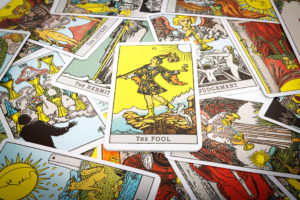
Humans have always sought knowledge or tried to solve complex mysteries. We find ourselves seeking answers to difficult questions, to know more about a present situation beyond available facts or even to gain a glimpse of the future. These desires have given rise to a wide range of divination methods and tools, including some that use ordinary objects without original ritualistic or magical purposes. You might be surprised to discover that tarot cards weren’t always used for divination, and that they possess a surprisingly humble and mundane origin.
Roots in the Muslim World
Tarot decks were likely imported into Europe from Egypt during the 1300s. During this time in history, Egypt was part of the Mamluk Sultanate, which also encompassed modern-day Israel, Jordan, Syria and the western coastline of Saudi Arabia. The World of Playing Cards documents that these decks were painstakingly illustrated, and often produced in special workshops. Games using these beautifully crafted playing cards were enjoyed as a pastime in noble, upper-class and royal households throughout the Islamic medieval world, which included the Mamluk Sultanate, various Turkish empires, Persia and India.
At First, It Was All Fun and Games
The first tarot decks in Europe were divided into four suits: batons, coins, swords and cups. These suits remained unchanged in Italian, Spanish and Portuguese decks during the Middle Ages, and with some minor upgrades, they are still used in those kinds of traditional decks today. You might notice they have transformed both in names and symbolism, corresponding with the contemporary suits of clubs, diamonds, spades and hearts. In fact, these playing card decks used today in many parts of the world are derived from French versions that had been developed by the late 1400s. According to Michael Dummett in his book “The Game of Tarot,” the French varieties were transformed from German editions that employed acorns, bells, leaves and hearts respectively as their suits.
From Playing Cards to Divination Tools
The earliest references to the use of tarot cards for divination date to the middle of the 16th century. However, Dummett notes that they were regularly employed for fortune-telling by the 1780s. Meanwhile, John Michael Greer revealed in “The New Encyclopedia of the Occult” that French occultist Jean-Baptiste Alliette issued a tarot deck for divination during the late 1700s. Designed with ancient Egyptian imagery and themes, his iteration included 78 cards containing both major arcana, or trump cards, and minor arcana of numbered and court cards depicting queens, kings, knights and jacks. This initial version is a basis for later editions such as the Rider-Waite-Smith version, the Tarot of Nine Paths developed by Art Rosengarten and the famous Thoth deck created by Aleister Crowley and Lady Frieda Harris.
Modern Divination Decks Use Old Italian Suits
While the French system of hearts, spades, clubs and diamonds has stuck with us in contemporary playing decks, tarot cards for divination utilize some version of the Italian suits. Today, you’ll usually see wands in place of batons and discs or pentacles used instead of coins, while the swords and cups suits remain. The Psychic Library has published a basic breakdown of the elements, ideals and zodiac signs associated with each suit. Wands typically correspond with fire elements, cups with water, swords with air, and discs or pentacles with earth.
The fascinating story behind our tarot decks once again proves the human tendencies of adoption, reusing and re-purposing. As tarot cards evolved from their beginnings in the Islamic world as a fun pastime, they transformed from being a curiosity in medieval Europe to becoming a new divination tool. They’ve blossomed into hundreds of editions in existence today, using principles for reading and interpretation borrowed from many different belief systems around the world.

